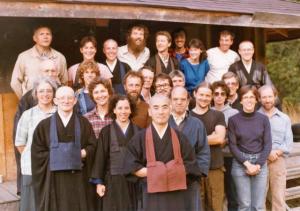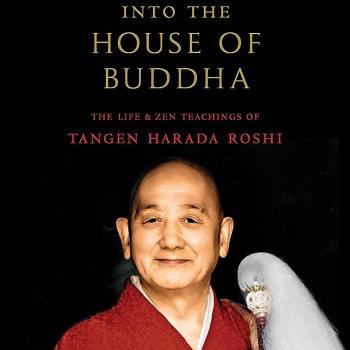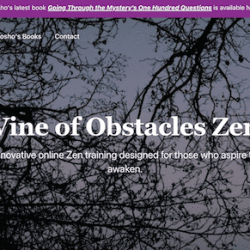
Unlike in 1984 when the above photo was taken at the end of a practice period (Katagiri Roshi is up front and center, I’m in the back on the right), meditation and mindfulness are booming and widely available. You can pick up basic meditation skills not only at dharma centers representing dozens of different lineages but also at yoga studios, community centers, and churches (usually of the progressive variety) from coast to coast. No need to shave your head and wear black. Even Target has been in on it for years, selling yoga mats and meditation cushions.
Case in point: Of the twenty-seven people in the above photo, only one, Katagiri Roshi, was a meditation teacher in 1984. At least eleven (that I know of) have since become meditation teachers, seven with Soto Zen dharma transmissions. See James Myoun Ford Roshi’s recent post for more on the graduation issue in Zen: “Of the Raw and the Cooked: A Zen Teacher Reflects on Dharma Transmission and Spiritual Practice.”
So like Keizan said,
A splendid blossom issues forth from the old plum tree
Thorns come forth at the same time
In other words, with success, problems arise. The problem I’d like to address in this post is how we use the word “teacher” to refer to folks with a wide range of training and experience. That fits with the American proclivity for leveling, often a wholesome thing, but in this case, I suggest, it is resulting in a tangle of confusion and misinformation.
The range of training and experience for meditation teachers
The most basic certification for a yoga teacher is 200 hours. Iyengar Yoga teachers, though, do a whole lot more. A person can become a Mindfulness Based Stress Reduction (MBSR) teacher for their 8-week course after an a eight-day training (Correction: I didn’t have this right in an earlier version). On the other hand, according to a recent survey, the average teacher in the Soto Zen Buddhist Association has been training for about twenty-five years. One of the minimum qualifications for membership in the American Zen Teachers Association is about 300 days of intensive retreat.
However, don’t get me wrong, there is also a lot a variation in the Zen world and an urgent need for quality control. At the top end, one woman recently became a fully authorized Zen teacher after twenty-five years of monastic training, fifty or so practice periods, and about 2,000 days of sesshin. Some people become teachers with little retreat time (less than one-hundred days of intensive retreat) and some have over a thousand days. I’m aware of one person who presents as a Zen teacher who has not done a single day of sesshin. Some have worked through extensive kōan curriculum and some have not. Some have studied the Zen buddhadharma, including the likes of Dōgen, and some have not. Some teachers have verified awakening experiences and some (i.e., almost all) do not.
All of these people are referred to by some or themselves as meditation teachers.
Depending on what you’re looking for in a teacher, that might be fine. If you want a little relaxation and centering, or to learn a well-established program like MBSR, a teacher with 200-hours and/or an eight-day training might be fine. If you’re looking to wake up from a “life story comprised of a series of complaints,” as a student recently put it, and dive deeply into this issue of birth and death, it is not.
Seems to me that most of the people with little training that present themselves as meditation teachers have positive intentions, but perhaps don’t appreciate the subtlety of the buddhadharma, are unaware of the possibilities for training and realization, and may not have met a true teacher. In addition, we have this huge cultural undercurrent encouraging us to be impatient with processes that take time and a tendency to be very creative with our bios. There’s also a particularly American form of arrogance that leads us to assert in a heartbeat, “Oh, I get that,” even when it’s taken our predecessors decades of practice.
And there are a few who present themselves as meditation teachers that are frauds.
Eskimos really do have 50 words for “snow”
We don’t have nearly that number in english for “teacher,” but we do have some: coach, trainer, guide, educator, tutor, instructor, master, mistress, mentor, guru, counselor (those from an online search).
Some of these don’t resonate, of course, like “mistress,” and it’d be impractical to have 50 grades of teachers, but we could have a few.
So I’d like to keep it simple and offer a modest proposal:
- Meditation facilitator: people that don’t have a lot of training but that can skillfully facilitate a beginner’s meditation
- Meditation teacher: people that have a moderate amount of training and experience and point people to more advanced skills, while sharing the possibilities and dharma purposes for meditation practice
- Meditation adept: people that have a heck-of-a-lot of training and deep experience and can help people wake up and live with it
I suspect that “Meditation adept” might stick in your craw. Adepts, after all, are supposed to be humble and self-effacing. And yet that humility might be adding to the problem and not really serving people.
A qualifier: I’m not quantifying these categories so as to prevent my head from exploding and so that they might be used more widely than in any one system – an important thing, in my view, to help consumers of meditation know what kind of training their teacher has.
A ground-swell of immediate implementation
I’m not quite dumb enough to think that this will catch on widely, but having seen a problem, I offer this as one solution – a solution from which thorns would grow.
By the way, I’ve turned off the comment section here – “Disqus” was a bit much for me – but you can find me on Facebook and join the conversation about this topic there.
_____________________________












